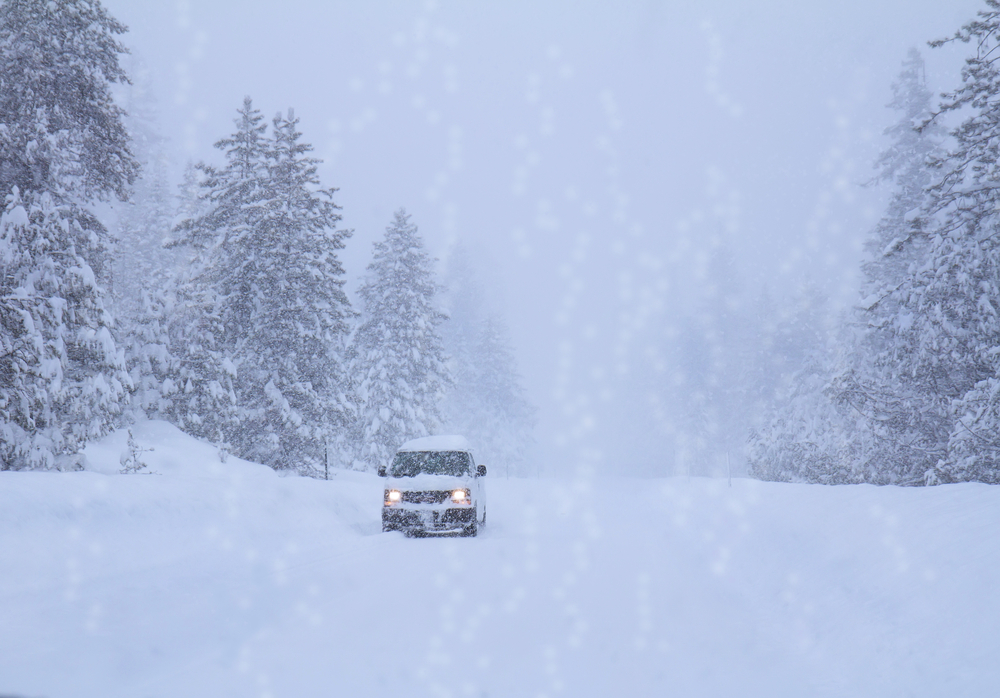Written by Joe Alton, M.D., Disaster Preparedness Expert & Author
It’s predicted to be a harsh winter and, for most in the U.S., this means trouble if someone gets stuck out on the road during a blizzard or other extreme conditions. Hypothermia (the effects on the body from exposure to cold) may occur on the wilderness trail, but also right in the driver’s seat of the family car. It’s important to have a plan in case you are stranded in your vehicle.
Your Car
Winter conditions don’t just affect people, they affect cars as well. Cold affects rubber and metal; it even decreases the battery’s efficiency. Tires become stiff and flat for the first few hundred yards. Your oil and other lubricants become thicker at cold temperatures. This makes the engine work harder.
Therefore, vehicles that will be doing duty in extreme cold should be “winterized”. This involves switching to a lighter viscosity oil, changing to snow tires, and choosing the right (anti-freeze) ratio of coolant to water. Gas tanks should never be less than half full.
Stranded!
1. Stay calm and don’t leave the car. It’s warmer there than outside and you have protection from the wind. Having adequate shelter is one of the keys to success, whether it’s in the wilderness or on a snow-covered highway.
2. Ventilation is preferable to asphyxiation. Crack a window on the side away from the wind for some fresh air. People talk about water and food being necessary for survival but, first, you’ll need air to breathe. Wet snow can block up your exhaust system, which causes carbon monoxide to enter the passenger compartment. Colorless and odorless, it’s a deadly gas that kills in enclosed spaces without ventilation. Clearing the exhaust pipe of snow and running the engine only ten minutes or so an hour will help prevent monoxide poisoning.
3. Group Hug. If you’re in a group, huddle together as best you can to create a warm pocket in the car.
4. Keep Moving. Rub your hands, put them in your armpits, or otherwise keep moving to make your muscles produce heat.
5. Don’t overexert yourself. If your car is stuck in the snow, you’ll want to dig yourself out. A lot of sweat, however, will cause clothing to become wet. Wet clothing loses its value as insulation and leads to hypothermia.
6. Let others know you’re there. If you have flares, use them. Flashing emergency lights on your vehicle will drain battery power, so use them only if you think someone might see them.
The Winter Car Kit
If you’re going to travel in very cold conditions, there are a certain number of items that you should keep in your vehicle. This is what an effective winter survival car kit contains:
- Wool Blankets. Wool can stay warm even when wet.
- Spare sets of dry clothes, including socks, hats, and mittens.
- Hard warmers or other instant heat packs (activated, usually, by shaking, they’ll last for hours)
- Matches, lighters and/or firestarters in case you need to manufacture heat.
- Candles, flashlights (keep batteries in backwards until you need them).
- Small multi-tool with blade, screwdrivers, pliers, etc.
- Larger combination tool like a foldable shovel (acts as a shovel but also an axe, saw, etc.)
- Sand or rock salt in plastic container (to give traction where needed.)
- Tow chain or rope.
- Flares.
- Jumper cables.
- Water, Food (energy bars, MREs, dehydrated soups, candies).
- Baby wipes for hygiene purposes.
- A first aid kit.
- Medications as needed.
- Tarp and duct tape (brightly colored ones will be more visible and aid rescue.)
- Metal cup, thermos, heat source (to melt snow, make soup, etc.)
- Noisemaker (whistle)
- Cell phone and charger
The items above will give you a head start in keeping safe and sound even if stranded. With a plan of action, a few supplies, and a little luck, you’ll survive even in the worst blizzard.
Your Life
You’re not a bear, so you can’t hibernate through the cold weather; you’ll have to live in it, so take measures to avoid becoming a victim of it. Many deaths from exposure are avoidable if simple precautions are taken.
The first question you should ask before you get in the car in cold weather is: What’s the forecast? Is it possible that you’re driving straight into trouble? Checking the weather beforehand is a lot better than finding out about it on the road.
The second question should be: “Is this trip necessary?” If the answer is “no”, you should stay home. For most people that work, however, the answer is “yes”. If you have no choice but to hit the road during a winter storm, drive as if your life depends on it (because it does). Brush ice and snow off windshields, side mirrors, or anywhere your view might be blocked. Don’t speed, tailgate, or weave in and out of traffic. Make turns slowly and deliberately; avoid quick stops and starts.
Notify someone of your travel plans before you head out, especially if you’re in rural areas. Take your cell phone with you but save it for emergencies. Your focus has to be on the road, not on texts from your friends.




No Comment